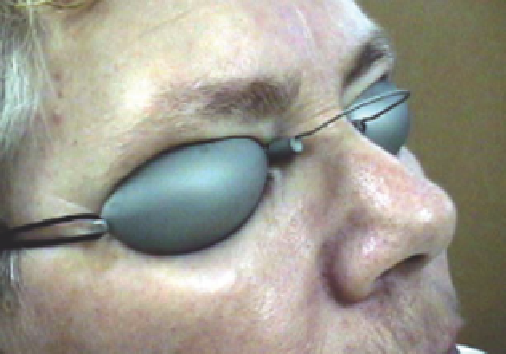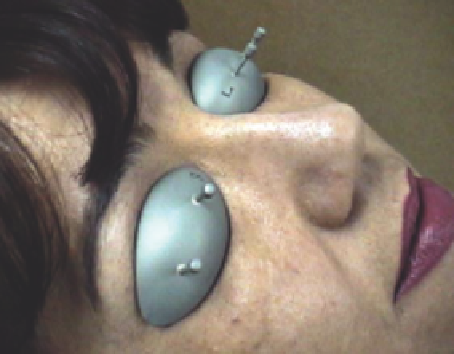Biomedical Engineering Reference
In-Depth Information
This means that personnel should NEVER use splash glasses,
prescription eyewear, face shields, tanning booth goggles, con-
tact lenses, or any other gear not specifi cally designed, tested,
and labeled for laser safety use. Infection control goggles do
not meet the eyewear selection criteria.
If the LSO has determined the entire treatment room as the
NOHA, then everyone in the room must wear eye protection
having the same level of optical density, eliminating the use of
observer glasses (low OD or marked “for observation only”). It
is important that users wear glasses that will allow enough
adequate visible light transmission.
Each individual should be responsible for examining their
glasses before use, to verify the correct labels, and to assess
whether or not the glasses are in proper condition. Look for
scratches, cracks, or discoloration in the lenses, as well as loose
connections or damage to the frame. If the lenses are discol-
ored as a result of improper cleaning (alcohol degrades optical
coatings) or prolonged light exposure (photobleaching), the
optical density will be less than expected and the glasses will
not provide proper protection.
Regardless of routine safety inspections by the LSO, or assur-
ance by the rental company technician, each individual must
ensure that the glasses he or she uses are the right ones and that
they are in safe condition, every time they are used
.
During fi beroptic procedures, even when the physician is
working from the video monitor, he or she should wear the
safety glasses. It is a known hazard, as fi bers can break or
become disconnected, resulting in unanticipated transmission
of laser energy in the room. Should that happen, the user may
be exposed to laser radiation above the MPE level.
Safety eyewear is the best method of providing patient eye
protection (Fig. 17.6). Straps or elastic bands should be in place
to keep the goggles from slipping out of place when the patient
moves or is repositioned. If unable to wear goggles, due to
treatment in the periorbital area, metal corneal eye shields or
tightly fi tting orbital goggles should be used to prevent damage
to the eye. Plastics may not withstand the impact of a laser, and
most have not been properly tested for this type of use.
If unsure, request the testing specifi cations used by the man-
ufacturer, to be sure that the product in question has been
tested with the wavelength and within the clinical parameters
to be used. If the documentation is not available, do not use
the product.
All staff in the room must wear protective eyewear at all
times during laser use, with no exceptions. Remember that eye
injury is completely preventable if everyone is properly trained
and uses proper eye protection.
Flammability and Reflection
The skin and other tissues of all patients and perioperative
personnel must be protected from unintended exposure to the
laser beam, as well as all personnel in the room.
Flammability is a potential laser hazard associated with
most high-power systems, but only rarely in the use of low-
power or diffuse beams. Many fl ammable products are used
routinely in clinical procedures, and the LSO as well as every-
one on the laser team must continually assess products and
devices in use in the laser target site, for compatibility with the
beam, and potential hazards. These items may include dry or
unwoven fabrics, plastic, rubber, solutions containing alcohol,
tape removers, skin degreasers, disposables, and skin prepara-
tion solutions.
Solutions that contain iodophors, (Hibiclens, Betadine, etc.)
must be thoroughly dry before fi ring the laser, as heat can
cause a chemical burn to the skin if it interacts with wet solu-
tion. All of these, as well as many other products, can become
a fi re hazard when exposed to the heat produced by a high-
intensity laser beam as they are fl ammable.
Some drapes are nonfl ammable, but melt when heated.
These may not cause fl ame, but can still present a severe haz-
ard by containing heat and in some cases, fl ames, under the
material, and as it melts can cause injury. These unwoven fab-
rics require smothering to extinguish them. The facilities that
use such drapes should have a fi re blanket installed in the
room.
An open basin of water should be available whenever a laser
is used. This serves to extinguish fi res caused by ignition of
fabric, sponges, etc. on the surgical fi eld. The basin should be
positioned near the laser operator.
A standard electrical equipment fi re extinguisher should be
conveniently installed near every laser room. The device
should not be attached to the laser, the supply cart, or the
(
A
)
(
B
)
Figure 17.6
(
A
) Periorbital eye shields protect against all laser wavelengths and fi t snugly inside the orbital ridge for procedures on the face. (
B
) Individual eye
shields can be used one at a time to protect the non-operative eye during most types of laser procedures.
Source
: Photos courtesy of Oculoplastik, Canada.

















